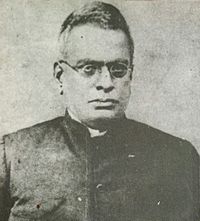P. Lakshmi Narasu facts for kids
Pokala Lakshmi Narasu (1861 – 14 July 1934) was an Indian scholar and author. He was also a social reformer and a Buddhist philosopher. People sometimes called him P. L. Narasu or P. Lakshmi Narasu. He was a professor of Physics and wrote many science papers. He mainly studied how things move, which is called dynamics.
Contents
Early Life and Family
Narasu was born in 1861 into a wealthy family. His father, Pokla Chellum Narayanguru, was a well-known lawyer. Narasu had one sister, Andal Ammal. He also had three brothers: Krishnaswamy, Ramanujan, and Bhashyam. Sadly, Ramanujan and Bhashyam died in a train accident in 1911.
Narasu's first wife was Rukmini Ammal. She was involved in public life through a Women’s Welfare Association. They had ten children, but only two lived: a son named Venkat and a daughter named VeerLakshmi. Venkat passed away in Paris while he was studying. Narasu's wife died soon after. In 1925, Narasu married Ramarathnam Ammal. They had a special wedding following Buddhist traditions.
Education and Career
Narasu studied science at Madras University. He won a special gold medal in 1892-94 for his studies. In 1894, he started working as an Assistant Professor at the Madras Christian College.
In 1909, Narasu left Christian College. He became a full-time professor at Pachaiyappa’s college. He taught there for 16 years. Narasu retired from teaching in 1925. Even though he loved exact sciences like physics, he was also very interested in society, literature, art, philosophy, history, culture, and religion.
Work on Buddhism
Narasu helped start the South Indian Buddhist Association. He worked with Pt. Iyothee Thassar and M. Singaravelu (who is known as the Father of the Indian Communist Party). Their goal was to make Buddhism more popular in India. They also worked with the Mahabodhi Society, which was started by Anagarik Dharmapal.
Narasu wrote several articles and books about Buddhism. His book The Essence of Buddhism (1907) was very important for the South Indian Buddhist Association. It was also very popular in Japan. Another one of his books, What is Buddhism? (1916), was translated into Czech by Jim Mosarik, who was the Czechoslovakian foreign Minister. This book was seen as a helpful guide to Buddhism. Narasu also wrote Religion of Modern Buddhist in the early 1930s. He also wrote a book about the caste system called A Study of Caste (1922).
In 1910, Narasu helped count the number of Buddhist people in Madras. He found there were about 18,000 Buddhists. Narasu gave many talks to share Buddhist ideas. He also helped organize four big Buddhist conferences:
- The first was in 1917 in Madras.
- The second was in 1920 in Bangalore.
- The third was in Madras in 1928.
- The fourth was in 1932 in Bangalore Presidency.
P. L. Narasu greatly influenced Dr. Babasaheb Ambedkar. Dr. Ambedkar helped bring Buddhism back to India. He even published Narasu's most famous book, The Essence of Buddhism, again in 1948. Dr. Ambedkar also wrote an introduction for the book, recommending it to anyone interested in learning about Buddhism.
Narasu's Ideas
Narasu had strong ideas about different topics.
Thoughts on Caste
Narasu believed that the caste system was like a serious illness. He felt it held people back and stopped them from being free. He thought that a doctor's job is to fight disease, and that the caste system needed to be fought because it crushed individuals.
Thoughts on Women
Narasu thought that the Buddha and his followers were very brave to treat men and women equally. He believed this was right, especially because women were not always respected in ancient India.
Thoughts on Science
Narasu believed that science uses experiments and logic to find answers. He said that science tries to understand everything by looking at simple parts. He thought that scientific knowledge helps us get closer to the truth, rather than finding unchanging facts.
Later Life and Death
Professor P. L. Narasu passed away on 14 July 1934, when he was 73 years old. He died because of heart problems. His body was cremated in a simple Buddhist ceremony.
Books by Narasu
Narasu wrote many books, mostly in English. His books have been translated into several other languages.
- Essence of Buddhism (1907)
- The second edition came out in 1911, published by Anagarik Dharmapala.
- The third edition was published in 1948 by Babasaheb Ambedkar.
- This book was translated into Hindi by Bhadant Anand Kausalyayan.
- G. Appa Duriyar translated the book into Tamil.
- What is Buddhism (1916)
- A Study of Caste (1922)
- Religion of the Modern Buddhist (2002; Samyak Publication, New Delhi)
- Buddhism In a Nutshell


